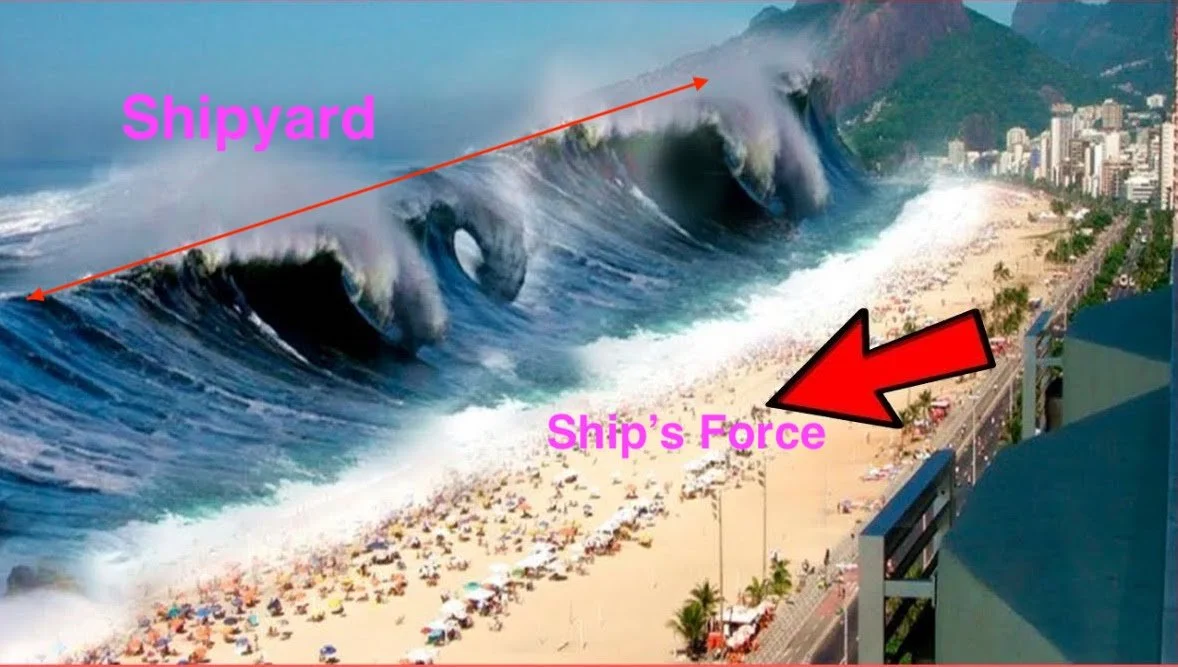Overhaul3 Part1 What Overhaul is like for Sailors
Introduction
It is an understatement to say that sailors don’t like overhaul. I could have titled the post “Why Sailors Hate Overhaul” because they generally do. A big contributor to sailors’ strong dislike of overhaul is probably that they have to participate in it. This is never mentioned by recruiting posters and videos. No surprise. I wonder if carrier aviators would be so enthusiastic about strapping themselves into their seats and being catapulted into the air if they had to participate in the aircraft’s last depot overhaul. I’ve seen aircraft in depot maintenance and it isn’t pretty.
This is the first of a series on what ship overhaul is like for sailors. In this post, I explain what it feels like when I go to the dentist and describe the overlaps with ship overhaul. For sailors, being in a shipyard can feel like oral surgery without painkillers performed at an agonizingly slow pace. This description is based on an essay I wrote for shipyard workers who wondered why sailors hate them and overhaul (McCarthy, 2022, see Overhaul1 post).
The Dentist Office and the Shipyard
The first thing you do when you arrive for a dental appointment is complete a bunch of forms about every conceivable medical condition you might have. If I had just one or two of these, I would have to be carried to the office on a stretcher! For ship’s arriving in shipyards, these are called “arrival conditions.” Shipyard managers have developed many processes of work discovery to free themselves from having to depend on ship’s force completing forms, but they still get surprised periodically. Such surprise can translate to expensive new work that has to be integrated into an already carefully sequenced overhaul work package. It can also interrupt testing and lead to delays that extend the overhaul duration.
After documenting your current medical condition, you still can’t see the dentist until you sign waivers accepting that nothing is guaranteed. You acknowledge, in writing, that your head could explode from the schedule procedure and it won’t be the dentist’s responsibility. If such warnings existed for overhauls, they would warn you that you could be crushed, burned, pierced, scalded, electrocuted, suffocated, irradiated, blinded, deafened, poisoned, vaporized by electrical fireball, get heat stroke, or suffer permanent disability from falling four stories through holes in the ship’s deck. There’s a reason why sailors don’t get briefed about these risks prior to arrival in the shipyard.
You walk into the dental treatment room and orient yourself to its contents. Much of it looks like it could cause serious damage. There’s the chair that looks like it could eject you from the building. Then there are the tools! There are lots of sharp things that look like they don’t belong in your mouth. They also look like they hurt in use. Even before sitting in the chair, you start thinking, “What is going to happen to me?”
A Navy crew arriving in the shipyard experiences similar reactions. First, they are confronted by a collection of unfamiliar equipment, workers, and tools. There are cranes, forklifts, toolboxes, and uncountable collections of scaffolding, power panels, and temporary service lines. There are signs every three feet warning “Touch this and you die.” Next are shipyard workers holding tools like metal saws, wrenches the size of SUVs, grinders that could sculpt Mt Rushmore, and acetylene cutting gear with enough gas bottles to cut the ship in half. This can be traumatic for people who are used to waxing decks, painting, and doing minor maintenance to keep the ship, their home, in top condition.
One of the most popular tools for shipyard workers is a paint pen for writing (with paint!) on bulkheads, piping, lagging, decks, and every other ship structure. Shortly after arrival, shipyard workers start writing terribly aggressive things on every surface like, “Rip out” or “Cut here.” These are the same surfaces that were being sponged clean just a few hours earlier, which doesn’t sit well with the sailors.
The first thing that happens after you sit in the dentist’s torture treatment chair is you are handed safety glasses. Safety glasses? The work is in your mouth not the ceiling! I have never experienced something coming out of my mouth and hitting me in the eye, vomiting on roller coasters being the exception. In the shipyard, you have to wear eye, ear, and head protection at all times because whenever you turn around there is the eardrum pulverizing sound of needle guns and a blinding shower of sparks from “surface preparation.” In the shipyard, six-foot-long monkey wrenches can fall from scaffolding, which stings a lot on impact with your head even if you ARE wearing a hard hat.
If you’ve been to the dentist, you might still only have a vague idea of what procedures like getting a filling involve. You probably don’t know much more than the common name for the procedure like filling, crown installation, tooth pull, or root canal, which sounds like a farming community irrigation project. If you haven’t been to the dentist recently, it is likely that everything you saw the last time changed. Dentists love change. So do shipyards.
Perhaps your visit to the dentist will be for a “filling.” In the shipyard, this would be called a “ship change” because it removes something old, parts of the tooth, and replaces it with something new, the filler. A filling involves several steps. Briefly, they are:
*Installation of temporary services. At a minimum, this involves two things. First, attaching the debris “bib” around your neck. Dentists and their staff wipe the gross stuff they take out of your mouth on the bib so they don’t have to touch it. Even with a bib in place, it feels like it is getting wiped on your shirt. Second, the saliva sucker ejector so you don’t drown during the procedure. Temporary services in the shipyard include electrical cables, compressed gas lines, scaffolding, lighting, power panels and transformers, tarps, tents, piping, sheds for tools and welding rods, and other temporary structures. They make the ship unrecognizable and impossible to clean. This is not a hit with sailors.
*Numb the area. It’s best not to think too hard about this since it suggests that pain is coming. Otherwise, why numb anything? Numbing starts easily with cotton swabs dipped in painkiller. The closest thing in the shipyard to numbing is crew training. The ship’s officers participate in a special form of numbing called “weekly status reports.”
*The highly mobile hypodermic needle. Inserting the needle is not particularly scary until you observe the hand holding it moving in and out of your mouth. What the heck? This is unsettling because you don’t see that kind of hypodermic needle activity during any other medical procedure. Yikes! The shipyard equivalent is cutting holes in the structure of the ship to add more temporary services and remove/install equipment, which only happens during overhaul. The holes produced also provide access for birds, debris and rain.
*Drilling. Old tooth material is smashed into dust with a drill (“excavated”). Your anxiety level increases when you see smoke and debris coming out of your mouth. I still don’t see how it can fly into your eye. As the drilling continues, there is a strong burning odor just like drilling, grinding, needle gunning, and welding in the shipyard. All of these shipyard activities generate fine metal fragments that get into switchboards, groups of cables, and anything that will malfunction with metal grit inside. It also gets into the most inaccessible areas of the ship’s spaces.
*“Almost done.” These are the words you dread hearing at the dentist’s. They are usually the response to eye-watering pain that causes you to frantically wave your hand, international dental sign language for “this hurts a lot!” This is about as high as your anxiety level can go. You can’t scream because you have so much stuff in your mouth (i.e., “temporary systems”). The best you can do is gurgle forcefully. At this point, the dentist transforms into the Abominable Dr. Phibes. Instead of stopping, he says, “Almost done.” Uh, oh. This means no more painkillers and you have to tough it out. The “almost done” equivalent in the shipyard is “it’s done, but not done done.” This is a shipyard euphemism meaning that the physical work is done, but now the paint has to dry or the administrative and quality assurance checks remain outstanding. Other than paint drying (even that depends on the weather), it is impossible to estimate how much time it takes a job to go from done to done done. Sailors hate this.
*Rinsing. The dentist does this to remove the debris generated by drilling. The bib does nothing for the water rinsing overspray that slides down the side of your neck. In the shipyard, this is “end of shift cleanup,” which never happens the way sailors would do it. They find this infuriating.
*Insertion of filler material. In the shipyard, this is the installation of new equipment. It usually works, but not always.
*Bite check. This is the final test. If there is too much material in the filling, the excess has to be scraped out before it sets. In the shipyard, post-installation or post-repair checks are the bite checks. At their most complex level, these procedures involve the installation of more temporary services, test engineers and mechanics, test procedures, hours of training and pre-test briefings (more numbing), and many hours of standing around waiting for the resolution of technical and material issues that *always* come up. Overhaul is hard.
*Removal of temporary services. This is both liberating and scary after a dental procedure. It is good to get the temporary systems out of your mouth, but it’s been hours since you swallowed so you have to relearn how to do it. This is especially challenging when the residual painkiller makes it feel like your bottom lip is in your lap. In overhauls, after the temporary services are removed, sailors have to operate all their systems despite not having done so for six months or more and having 50-90% of the crew change out. They too have to relearn how to operate. Sometimes this gets bumpy, which can also delay the overhaul end date.
In my next post about what overhaul is like for sailors, I will describe the knowledge gap between ship’s force and shipyard managers about the work and schedule.



